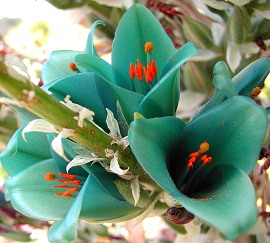Turquoise Puya

Puya berteroniana
Puya is easy to germinate. Any small container will do. You can use those plastic "6-pack" containers that nursery plants are sold in. Fill each container to within 1/2 of the top with soil. You can use regular potting soil, provided that you add 1 part of perlite or sand for every 2 parts soil, mixed well. After filling the containers, water the soil so that it is uniformly moist, but not soggy. Place 1 or 2 seeds on top, and sprinkle a very thin layer of soil on top - just enough to barely cover the seeds. Spray the top soil with a spray bottle and put the pots in a plastic bag and close it. Cut a couple of small holes in the bag for a little ventilation. Place the pots in a bright spot that's about 65-70 degrees. The seeds need some light to germinate, such as a fluorescent bulb. By the way, if you are inexperienced with growing seeds, start by planting only half of them.
Most of the seeds should sprout within 2-3 weeks, although allow up to 8 weeks for any slow ones. It's normal for a few seeds to be sterile and not sprout. Once you see little green leaves - celebrate - and then remove the bag. Spray the soil whenever the top half inch of soil feels dry, but avoid keeping the leaves wet for long periods of time. A well-ventilated spot is best. Give them either filtered sun, or 2 hours of morning sun plus bright shade the rest of the day. Transition them to more sun very gradually. About every 3-4 weeks, give them an hour more sun each day, until eventually they are in a half-day's sun, with some shade during the middle of the day. After about 2 years you can slowly transition them to full sun. It's best to grow them in a protected spot for the first 2-3 years, so you can keep an eye on them. Be patient with your Puya plants, as they are slow growers.
Long-term care: Water moderately whenever the soil is about 2/3 dry down where the roots are. I recommend using a moisture meter probe to monitor the soil moisture. You can buy this at garden and hardware stores for about $4. Simply stick the probe in the soil at the level where the roots are, and water whenever the needle is about 1 or 2 on a scale of 10. Avoid letting the soil completely dry out, but don't let it stay soggy either. Never let the pots sit in a tray of water. Feed once a month during periods of active growth, using an ordinary complete vegetable fertilizer at 1/3 the recommended dose. Don't overfeed them - it will not speed their growth and may end up poisoning them.
Repot your plants to a larger container whenever the roots start circling around the bottom of the container or poke out of the holes. A good rule of thumb is give them a pot that's about as big as they are, or slightly smaller. Protect your plants from frost for at least the first winter or two. Also keep them fairly dry during the winter, unless temperatures are above freezing. They will bloom the fastest if protected from frost. During the summer, it's best to give them some mid-day shade if it gets into the upper 90s or above.
By the way, the leaves will develop a white powder on them. This is normal!
Have fun growing them!
Jeff
Strange Wonderful Things